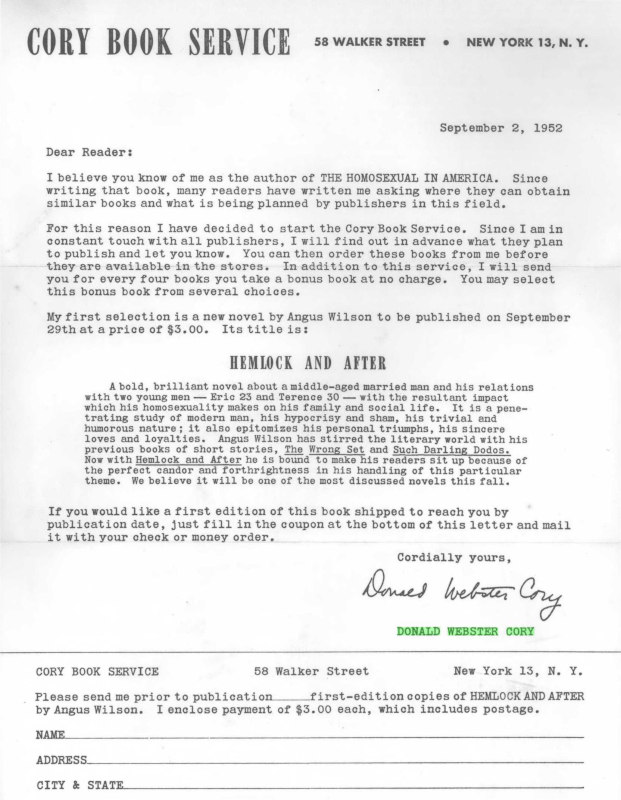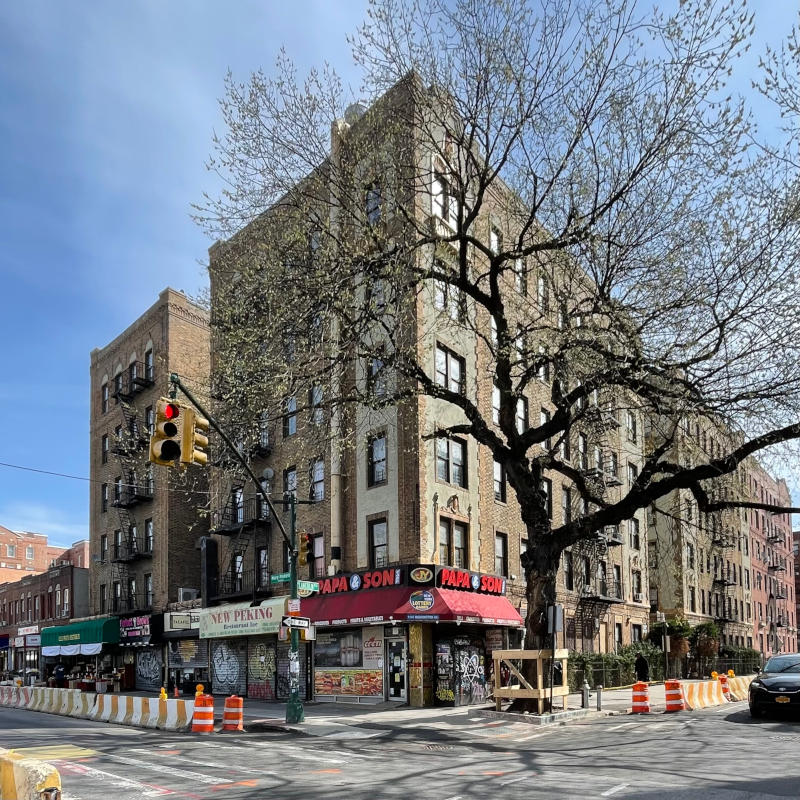
Edward Sagarin Residence
also known by his pseudonym Donald Webster Cory
overview
Perhaps better known by his pseudonym Donald Webster Cory, Edward Sagarin was the author of The Homosexual in America: A Subjective Approach (1951), one of the first published works to discuss homosexuality from the perspective of a homosexual.
Sagarin, who was active in homophile rights groups like the Mattachine Society, later became a divisive figure in the fight for gay liberation after the 1969 Stonewall uprising and lived in this apartment building from 1941 until his death in 1986.
History
In 1941, a few years after marrying his wife Gertrude in 1936, Edward Sagarin (1913-1986) moved into an apartment at 57 Lincoln Road, originally known as Lincoln Gardens. The couple met through their shared participation in left-wing student groups, and while Sagarin had an active gay life and a primary attraction toward men, he described Gertrude as “the only woman I have ever had erotic feelings toward.”
A college dropout as a result of the Great Depression, Sagarin worked in perfumery. He began writing The Homosexual in America: A Subjective Approach, which was published in 1951 under his pseudonym, Donald Webster Cory. Unlike prior discussions of human sexuality, such as Alfred Kinsey’s objective study that was published a few years prior, Sagarin’s work remarked on homosexuals from the perspective of a homosexual, providing anecdotal descriptions of gay life and discrimination. Through Cory, Sagarin argued that homosexuals deserved acceptance rather than criminalization. His discussion of homosexuals as an oppressed minority was highly influential on the thinking of future homophile leaders.
The first printing of The Homosexual in America sold out and the book was republished seven times before being issued in paperback in 1963. Sagarin received a plethora of letters responding to his book and inquiring about other queer literature. From these letters, he developed a mailing list, the Cory Book Service, that provided recommendations for gay titles to its recipients. Sagarin operated the service, the largest gay mailing list in the United States at that time, out of an office at 58 Walker Street in 1952, later moving to 237 E 56th Street (demolished) in 1953, then 80 East 11th Street (demolished) in 1954.
The Service’s large audience allowed it to offer exclusive printings of unpublished works and discounts for multiple purchases. It promoted titles such as Charioteer by Mary Renault, Hemlock and After by Angus Wilson, The World in the Evening by Christopher Isherwood, and Homosexuality and the Western Christian Tradition by Derrick Bailey.
Before helping found the New York Area Council of the Mattachine Society, Inc., Tony Segura volunteered for the book service, which stopped distribution for a short while after being targeted by obscenity laws that fined publishers of “lewd” materials. Sagarin sold the list to Arthur Richmond, who operated the service until his death, after which it was sold to Elsie Carlton, a liberal homemaker on Long Island who operated it under a new name as the Winston Book Service, until 1969.
Sagarin became active in the homophile movement, contributing to ONE Magazine under his pen name and speaking at the Mattachine Society’s fifth national convention in 1958 at the Barbizon-Plaza Hotel before formally joining the group in 1962.
Sagarin began taking night classes at Brooklyn College in 1958, completing a BA and MA in sociology before entering NYU’s PhD program, where he wrote his dissertation, entitled Structure and Ideology in an Association of Deviants, on the Mattachine Society and its predecessor organizations, graduating in 1966. That same year, Sagarin became a sociology professor at Baruch College, specializing in deviancy.
Concurrent with his rise in academics, Sagarin began developing grievances with the homophile movement. He stopped contributing to ONE Magazine after hearing that its publishers planned to start their own book mailing list and left the Mattachine Society entirely in 1965 after a fracture in the organization. By that point, Sagarin believed that homosexuality was a sickness that could be cured, standing in stark opposition to other gay activists and contradictory to his earlier writings.
By the 1970s, Sagarin became a wholesale critic of the post-Stonewall gay liberation movement, arguing that while homosexuality should not be criminalized, it was a pathology that could and should be cured. At the same time, Sagarin continued to cruise, and was a familiar face to the hustlers in Times Square.
Since the publishing of The Homosexual in America, Sagarin maintained a strong separation between his two lives, with his Donald Webster Cory identity completely separate from his academic one. This came to an end, however, at the 1974 American Sociological Society conference, where fellow researcher Laud Humphrey repeatedly referred to him as “Mr. Cory” during a panel after Sagarin continuously maligned the movement for gay liberation.
Sagarin became less public as an academic after this incident, publishing less and shifting his research focus away from homosexuality. Described by Martin Duberman as the “father of the homophile movement,” and later derided by Frank Kameny as the “senile Grandfather of the Homophile Movement,” Sagarin’s transition from homophile activist to enemy of the movement left a divisive legacy. He died of a heart attack in 1986.
Entry by Evan Tuten, project consultant (August 2022).
NOTE: Names above in bold indicate LGBT people.
Building Information
- Architect or Builder: William Hohauser
- Year Built: 1925
Sources
Claude J. Summers, “Sagarin, Edward (Donald Webster Cory) (1913-1986),” glbtq, Inc., 2004, bit.ly/3yvRyiu.
David K. Johnson, Buying Gay: How Physique Entrepreneurs Sparked a Movement (New York: Columbia University Press, 2019).
Edward Sagarin, “Structure and Ideology in an Association of Deviants,” Ph.D. dissertation, New York University, 1966, 74-76.
Edward Sagarin, The Homosexual in America: A Subjective Approach (New York: Greenberg Press, 1951).
Martin Duberman, “The ‘Father’ of the Homophile Movement,” Harvard Gay and Lesbian Review (1997), 69-94, from Left Out: The Politics of Exclusion (New York: Basic Books, 1999).
Michael Waters, “The Gay Book Club that Helped Spark the Gay-Rights Movement,” The New Yorker, October 5, 2021, bit.ly/3ypKLXp.
New York City Directories (1941-1986).
Rick Valelly, “The Conflicted Gay Pioneer,” The American Prospect, October 8, 2013, bit.ly/3ywgAOu.
Vernon L. Bullough, Before Stonewall: Activists for Gay and Lesbian Rights in Historical Context (United Kingdom: Routledge, 2002).
Do you have more information about this site?
This project is enriched by your participation! Do you have your own images of this site? Or a story to share? Would you like to suggest a different historic site?







